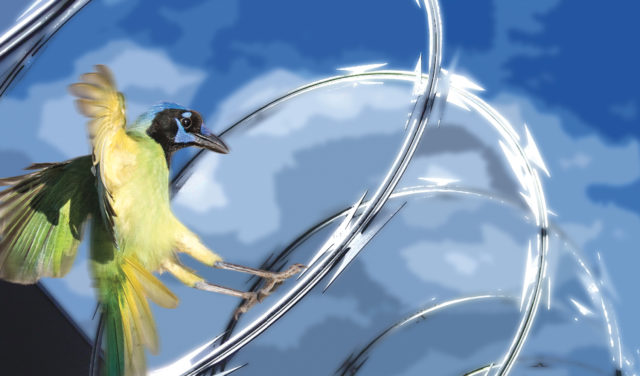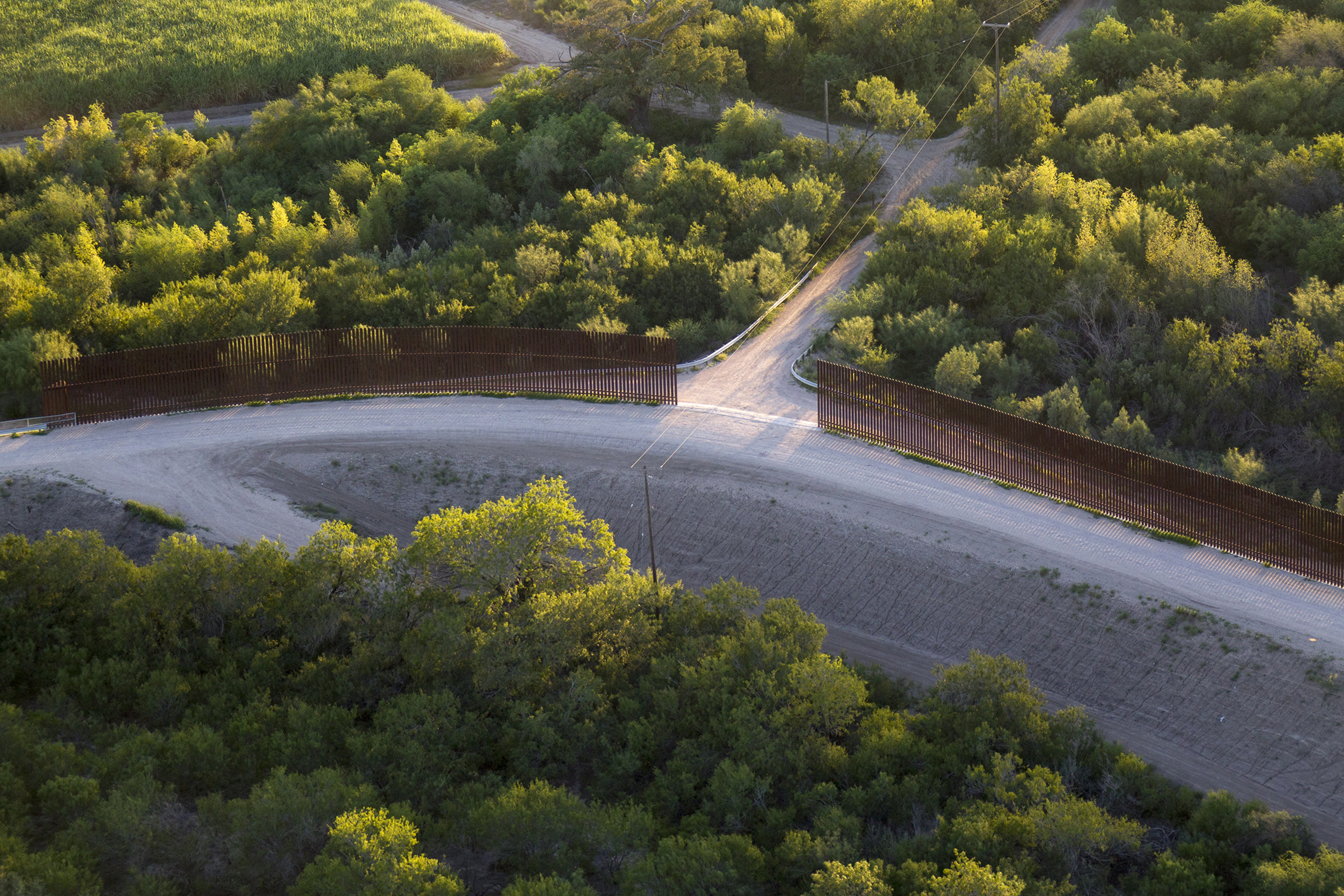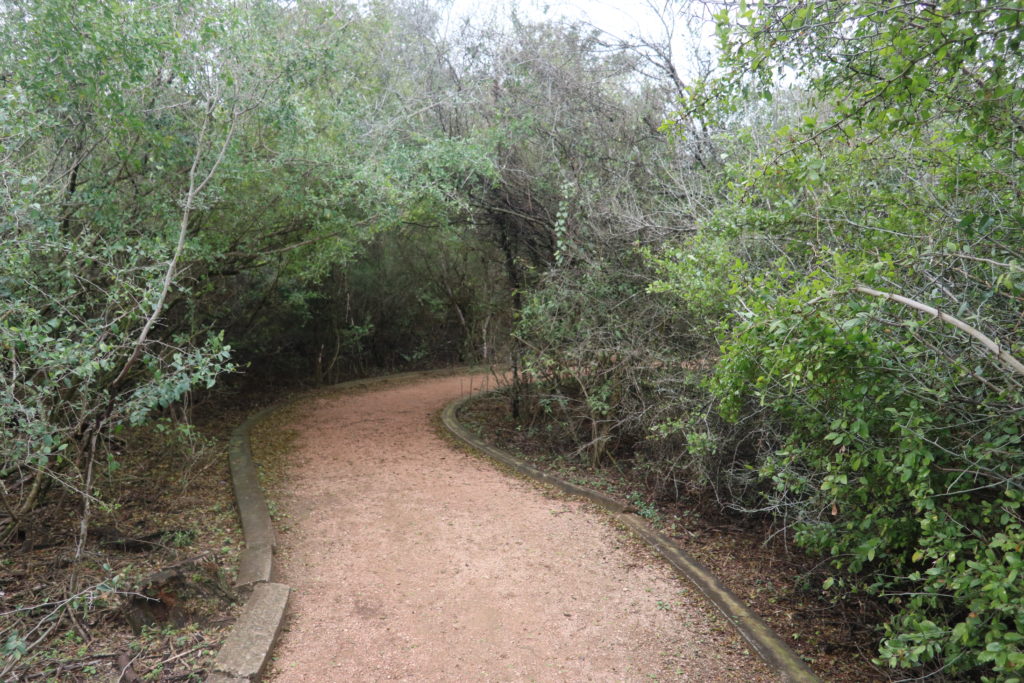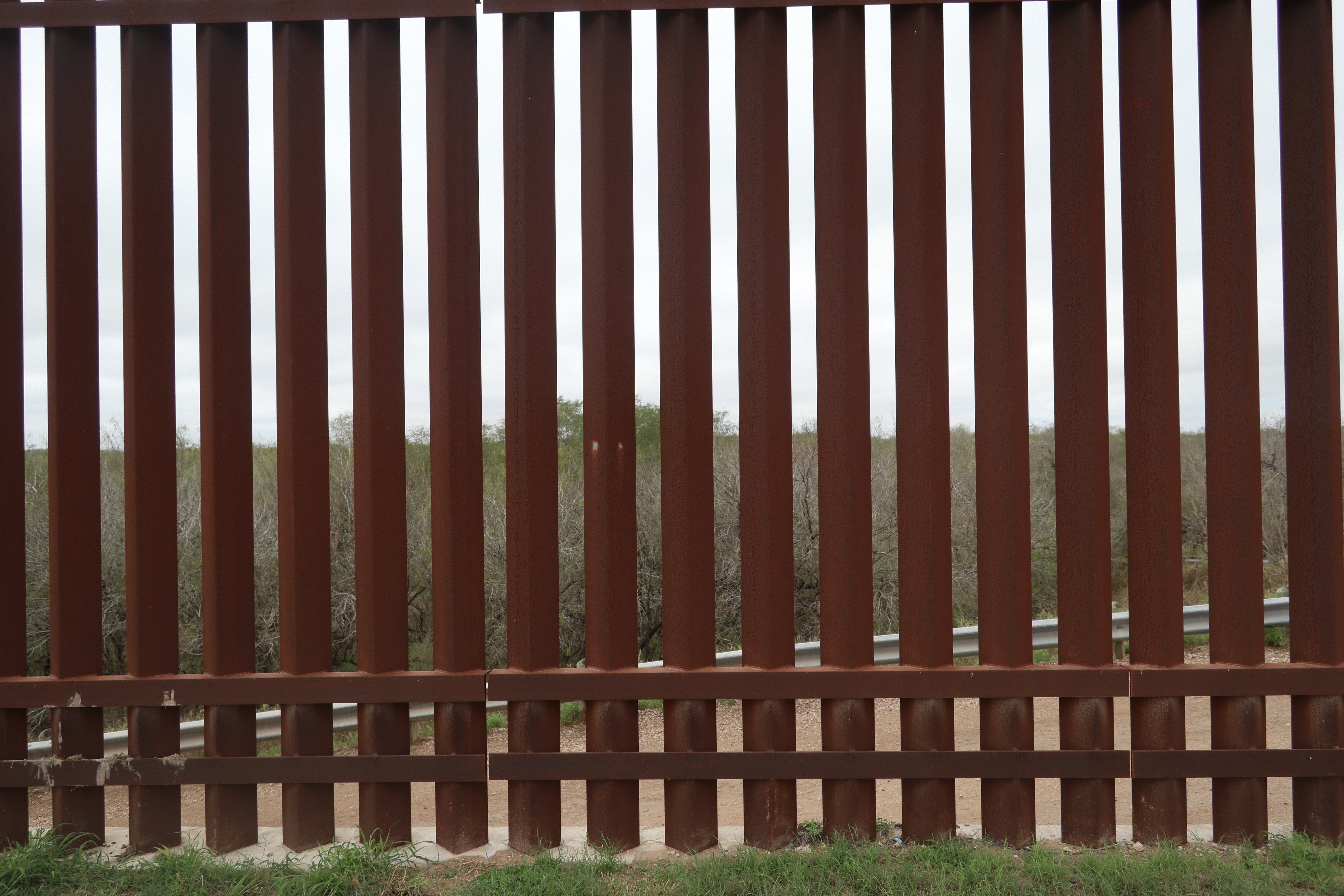
The road to Bentsen-Rio Grande Valley State Park is as flat as the rest of Texas and lined with palm trees — the tall, slender kind that arc elegantly against clear blue skies. “These are Washingtonia palms,” Patti Rubio says, one hand on the wheel, the other taping the window with her knuckle. “Some people, they’ll be like: ‘I know I’m home when I see the palms!’ But man, I see them, and the indigenous woman in me cries.”
Rubio, an environmental educator and local birding expert, talks with her whole body. When animals and plants are the subject, her large brown eyes widen, her smile broadens. But when politics come up, she rounds her shoulders and her mouth droops, unless she’s particularly enraged — then she snaps into a focused scowl, like she is right now.
Rubio works at the National Butterfly Center, a swath of privately protected land down the road from the state park. We’ve come to Bentsen-Rio Grande Valley State Park so she can show me what makes this region of Texas, the very southeast tip, so special: its rare birds, the millions of butterflies, and the most contentious section of the U.S.-Mexico border.
We turn left onto South Bentsen Palm Drive, and she raps her knuckle against the window again as we pass a cluster of broad and stocky ebony trees, which are native to the Rio Grande Valley, she tells me. She points to a dirt pull-out, semi-hidden and shaded by the trees. Border Patrol, she says, that’s where they like to idle in their cars, though on this February morning, it’s empty. A few minutes later we pass a large stable, where Border Patrol keeps their horses, and a few minutes after that, we slow to a stop at the entrance of the state park.
Both Bentsen-Rio Grande Valley State Park and the National Butterfly Center protect tracts of rare ecosystems along the banks of the Rio Grande River. Until two years ago, state park employees were likely the only uniformed people you’d encounter on a birding expedition or a stroll on the trails. But since the 2016 elections, Border Patrol agents are now seen with increasing frequency, as both wildlife sanctuaries extend to the edge of the water in what happens to be the busiest sector of the U.S.-Mexico border. According to Customs and Border Patrol (CBP) data, 162,000 people were apprehended in November 2018 between the cities of McAllen and Reynosa, north and south of the wildlife refuges, respectively.
The militarization of the Rio Grande Valley — ever present helicopters, patrolling agents, limited access to public and private land — has further intensified since March 2018, when the Department of Homeland Security (DHS) was authorized to build sections of physical barriers between McAllen and Reyonsa, on the edge of the river’s floodplain, which is anywhere between one and two miles inland and just a few hundred yards south of both sanctuaries’ visitor centers. If the wall is built, as much as 70 percent of the protected land will soon become a “no man’s land” sandwiched between the wall and the actual border line, inaccessible to private or public parties.

Rubio is part of a coalition of local folks trying to stop the wall’s construction, particularly the segments that will cut straight through these sensitive ecological areas. It feels like the Rio Grande Valley’s final frontier, in many ways; less than 5 percent of the region’s native ecosystem remains.
“Honestly, I’m exhausted,” Rubio says of her resistance-organizing efforts. “That’s the story of our lives down here, we can’t afford to stop.”
She explains their fight to preserve what’s left of the native ecosystem isn’t only about the health of the south-Texas flora and fauna; it’s also about preserving the value of their heritage and culture. Hundreds of thousands of folks in the Rio Grande Valley, like Rubio, have generational roots running far deeper than the roots of Washingtonia palms; these people have been landscaped and pruned, uprooted and manipulated just as much as the fertile river delta.
Though this area has been called the Rio Grande Valley for the past 100 years and folks today (including Rubio) identify proudly as “valley kids,” it’s not, by any definition, a valley — it’s the final 150 miles of the Rio Grande River before it spills into the Gulf of Mexico, a flat, sediment-rich riparian zone that’s been home to hundreds of flora and fauna species for centuries.

A 900-year-old Montezuma Cypress tree, for example, is rooted within the floodplain, now just 200 yards south of a section of wall that’s already been built. Endangered animals like the ocelot and plants like the star cactus have no more habitat in the U.S. (and in some cases, the world) than what remains protected right now in the Rio Grande river delta. But if DHS plans move forward as outlined in federal documents and bolstered by President Trump’s recent “national emergency” announcement, the delta will be the next site for border wall construction.
The wall is scheduled to be built on top of an earthen levee system that already exists, tracing the northern edge of the river’s floodplain, in compliance with a 1970 U.S.-Mexico treaty that prevents barrier construction within flood zones. The levees were originally intended to help create a protected natural highway of sorts for the ocelot to find mates and food, but last year, the president waived 23 environmental laws in order to expedite construction.
“Wildlife has no chance,” Rubio says. “Animals will either die of dehydration or they’ll die of starvation. They’re not going to be able to migrate to find a mate, they’re not going to be able to move safely… every living space needs space — [and] just like us, every living thing needs space.”
Before Bentsen-Rio Grande Valley State Park became a state park, the land belonged to the Bentsen Family, whose patriarch, Lloyd Bentsen (father of the famed Texas Senator of the same name) moved to Texas from South Dakota in 1918 on the hunt for ranching, energy development and real estate opportunities. At that time, the majority of folks in the region were a mix of descendants from Spanish settlements, Mexican migrants and members of the indigenous Carrizo/Comecrudo tribe.
The elder Bentsen was part of a cohort of Anglo ranchers that introduced the term “valley” to the region as a branding mechanism — they wanted to draw more wealth and development to the area and launched a campaign eventually known as the “Magic Valley Movement.”
They gave the Valley a makeover. Native Sabal palms, shorter and with thicker fronds, were uprooted; the Washingtonia palms lined the streets instead. Grasses were planted. Roads were widened. Cheap labor, cheap land and cheap water were advertised perks. Within a decade, land ownership flipped from majority Latino to majority Anglo.
“They brought in an outside non-native plant to exploit people, and that’s what hurts,” Rubio explains. “Sometimes I look at Washingtonians, and the only thing I see is people that were taken advantage of. It does hurt because my grandparents, my aunts and uncles, my mother, they worked in the field and they weren’t given what they should have been given as far as respect, breaks, money.”

The Sabal palms were too short, too stocky for Anglo landscaping preferences. The thorn bush forests native to the delta are never treated with romantic flair like other Western landscapes. Often, Rubio feels like American society is pressuring her to get a makeover, too. Her brown skin, her glossy voluminous hair — many of her physical characteristics aren’t appreciated in a lot of mainstream American media. She sees that reflected in the world around her, too. “When I was little,” Rubio tells me, “I put Clorox in water in a sink, and I tried to bleach my skin, because I thought I was ugly because I was brown.” When her submerged forearms started to burn, she thought, “Oh good, it’s working. I’m gonna be pretty.”
She continues, “There’s this feeling of being inferior because I’m a woman of color, and the thing is, I’m not inferior, and because I’m a woman of color does not mean anything less than the person to the left or the right of me, and it just so happens the universe decided, ‘Guess what? You’re going to be this lovely shade of brown,’ and that’s just so it’s not the same old thing. That’s all it is.”
But when you aren’t taught to see value or beauty in your natural self, nor value or beauty in the natural landscape of your home, where do you cultivate a sense of value, or even an understanding of who you are in the context of where you live? Neither of us know.
Rubio and I enter Bentsen-Rio Grande Valley State Park (on foot, no private cars are allowed) and pay the $5 admission fee. We hop in a 12-person minibus outside the visitor center, driven by a state park employee who will point out the birds and plants along the way.
First, though, we have to drive up and over the earthen levee in order to access the vast majority of the park, and the richest birding spots. Two Border Patrol trucks are idling on the levee as we drive by, their exhaust pipes emitting visible grayish fumes.
“Looks like they really care about the environment,” I say, and Rubio snorts. The state park employee can’t help but smile either. I ask the driver what’ll happen when border wall construction starts here. He declines to comment. Construction equipment and surveyors were seen in the wildlife refuge plots adjacent to the park and the National Butterfly Center at the beginning of February, just two weeks prior to this visit.

At this time, we’re all still in the throes of the longest government shutdown in history, so tensions everywhere in the Valley are high — it’s a largely democratic pocket of Texas and the majority of elected officials and folks native and non-native alike who live here year-round are outwardly opposed to even the general concept of a border wall. Rubio, like many, grew up walking back and forth across the river with her family, going out to dinner, attending church, shopping and going to the doctor in Mexico. While the militarization has made that life no longer possible, animals still depend on the ability to move freely north and south of the river, across invisible lines.
Despite the high rate of apprehended, undocumented immigrants and a poverty rate three times the national average, McAllen has consistently ranked as one of the safest cities of its size in the nation. Many folks rely on the millions of dollars of ecotourism the region generates each year. The wall would present economic and social changes to which many locals would have difficulty adjusting. Because many of them are poor and most of them are brown, Rubio believes the federal government isn’t paying those in the Rio Grande Valley the same attention or care other more privileged communities might receive. After helping support and organize the Standing Rock camp in North Dakota in 2016, Rubio sees similar power structures at play, now in her own hometown.
As we wind around the state park in the van, we’re surrounded by mesquite and ebony trees, thick tamaulipan thornscrub is sprinkled in between. We pass egg-yolk yellow Altamira orioles; green jays call out their cheh cheh cheh; large, proud and pheasant-like chachalacas squawk; a javelina (a rodent that looks like a wiry-haired pig and is as large as a medium-sized dog) waddles across a grass clearing. If you want an idea of what Texas once looked like, before the Spanish colonizers, before the Anglo ranchers, this is perhaps the best, last place left to see it.

Truth is, if the wall goes up, the park will most likely close. The National Butterfly Center, too. With so much of both sanctuaries’ land on the southern side of the levee, the fragmentation of the ecosystem will be devastating. While environmental- and human-rights groups have filed lawsuits against the federal administration, no legal action has been taken on behalf of local people.
The only solace Rubio finds now is in nature. While the Washingtonias distress her, she’s had no choice but to adapt to life under their shadow. “The only thing that brings me comfort is knowing that nature is at least benefiting [from the palms], and as we take away habitat, some are truly going to depend on that one tree to reproduce, to have their nest, to have their clutch.”
We leave the park and drive back out to South Bentsen Palm Drive. Rubio’s phone immediately starts ringing and vibrating. “Sorry, gotta look at this,” she says, pulling over.
As she sifts through the flood of messages — we’d had no cell service in the park — I watch Rubio’s shoulders, buoyed by our time in the park, round and fold again. Her lips purse into a scowl. She’s helping plan an upcoming protest. “I gotta get back home and deal with this,” she says — it’s not just flora and fauna that find peace in protected nature areas.
A few days later, on Feb. 14, the federal government reopened with a bipartisan congressional package that, at face value, might have seemed like a win for locals like Rubio. While the bill does include $1.375 billion for 55 additional miles of new border wall, it explicitly prohibits construction on the levees in Bentsen-Rio Grande Valley State Park and the National Butterfly Center.
But it doesn’t feel like a win for Rubio. As construction and clear-cutting on the southern side of the earthen levee is still a possibility, it’s only a matter of time before the impacts of fragmentation take a toll on the rest of the remaining ecosystem. The 900-year-old Montezuma Cypress won’t be protected.

The day after the government reopened, the president declared a “national emergency,” which would then eliminate any congressional protection of the state park and butterfly sanctuary. Though Congress voted to deny the emergency with a bill, the president vetoed the bill on March 14 and continues to push for the wall’s construction across the Rio Grande Valley.
Three days after the president’s national emergency declaration, Rubio joined a few dozen folks at the base of the 900-year-old tree. They carried in jugs of water, soaking its base. For a photo, they held up a banner that read: “Roots break walls.”
Rubio told me the slogan “has meaning behind many things, like culture, heritage and the environmental part. [You know] how we see plants growing through concrete? That’s us.”














